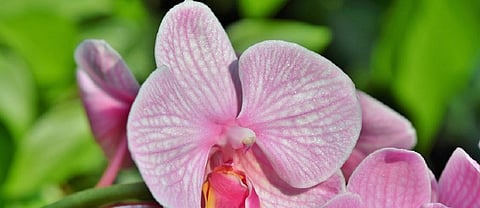India must conserve its orchid wealth
The family ‘Orchidaceae’ constitutes one of the largest families of flowering plants or angiosperms. They are a highly evolved family, with 600-800 genera and 25,000-35,000 species all over the globe.
Theophrastus (370-285 BC), known as the ‘Father of Botany’, gave the name ‘Orchids’ to these plants, based on the resemblance of paired underground tubers of the plants to male anatomy (the testes).
Because of this resemblance, people have the wrong notion that orchids possess aphrodisiac properties. These plants are perennial herbs with simple leaves.
Humanity has been familiar with orchids since the Vedic period. In the Rig Veda and the Atharva Veda (1500-800 BC), there is mention about Vanda tessallata (Rasna) and Flickingeria macrai (Sanjeevani) and their medicinal properties.
The Botanical Survey of India (BSI) has undertaken a study on ‘Orchidaceae’, only recently. There are 1,256 species of orchids in India, the BSI estimates.
Of the 1,256 species belonging to 155 genera, 388 species are endemic to India. Of the 388 endemic species, about one-third (128) species have been found to be growing in the Western Ghats.
The Himalayas possess the maximum orchid species among the ten bio-geographic zones of India. They are followed by the North East, Western Ghats, Deccan Plateau and Andaman & Nicobar Islands, respectively.
Orchids are divided into two groups, namely monopodial and sympodial. Monopodial orchids like Phalanopsis, Renanthera and Vanda grow continuously with a central stem.
Sympodial orchids like Cattleya and Cympodium have a main stem that terminates growth at the end of each season. A new shoot that grows from the base, becomes the bulbous stem known as pseudo-bulb, that flowers finally. The pseudo-bulb stores food and water and functions like bulbs.
Orchids are classified into three categories, namely epiphytic (plants that grow on another plant and rock boulders), terrestrial (plants that grow on land and climbers) and mycoheterotrophic (plants that derive nutrients from mycorrhizal fungi that are attached to the roots of a vascular or flowing plant).
Some 757 orchid species are epiphytic, 447 are terrestrial and 43 are mycoheterotrophic in India. Since India has a vast number of orchids, hilly areas have some orchids flowering almost throughout the year. Grasslands also provide habitat for certain terrestrial orchids.
The minute seeds of the orchids have only minimal reserves of nutrients. As a result, the seeds depend upon mycorrhizal fungi for the carbon resources to germinate.
As orchids have mycorrhizal specificity, pollinator specialisation, limited germination rates and sparse distribution in specific habitats, they are extremely susceptible to habitat disturbance.
Generally, the seeds require four to five years or more to attain flowering stage. The germination percentage is reported to be only about 0.3.
Under threat
Due to such reasons, the family consists of the maximum number of threatened species in nature.
The Orchidaceae family is under serious threat due to rapid destruction of natural habitat by deforestation, forest fire, overgrazing, felling of trees, rapid urbanisation and indiscriminate collection for floral business.
Orchid species with medicinal properties are becoming very rare and endangered due to over-exploitation, coupled with lack of awareness.
The multifaceted adaptability and fast replicating characteristics of invasive species like Eupatorium odoratum, Lantana camara, Parthenium hysterophorus, Ageratum conyzoides, etc, suppress the native flora, including orchids, in their original habitats.
Anthropogenic activities have thus become the major causes for the depletion of orchid wealth in Indian forests. Many orchids that were present in plenty in the past, have now become rare and endangered.
Because of its high value, endangered status and its significant role in the ecosystem, the family is often used as a flagship group in biological conservation. Orchids are considered as the indicators of the health of the forest ecosystem.
All species of Orchidaceae have been listed in the Endangered Species of Wild Fauna and Flora in Appendix II of the Convention of International Trade (CITES).
What can be done?
Orchid diversity can be saved from extinction only if earnest measures are undertaken on a war footing for conserving their natural habitats.
The field staff of the forest department across India, have to be trained to identify orchids, as they are the custodians of their habitats. Experts on orchids should be engaged to impart training to field staff.
Till now, only Blue Vanda, Red Vanda and Ladies slipper orchids have been included under Schedule VI of the Wild (Life) Protection Act, 1972, restricting collection from forests. All the species of the Orchidaceae family should be included in the Act for better protection.
Orchids must be protected through in situ and ex situ conservation for long-term survival in their natural habitats. Orchid seed banks and germplasm banks should be established.
By creating orchid conservation areas, tourists, college students and local people can be made aware of this plant wealth and its significance. With the support of the stakeholders, it may be easy to conserve this rare plant wealth.
Orchid sanctuaries can also be formed as is the case in Arunachal Pradesh and Sikkim. Arunachal Pradesh, also known as ‘Orchid Paradise’, is the first to establish the Sessa orchid Sanctuary exclusively for orchids. Assam is the second state that has set up the Deorali Orchid Sanctuary.


